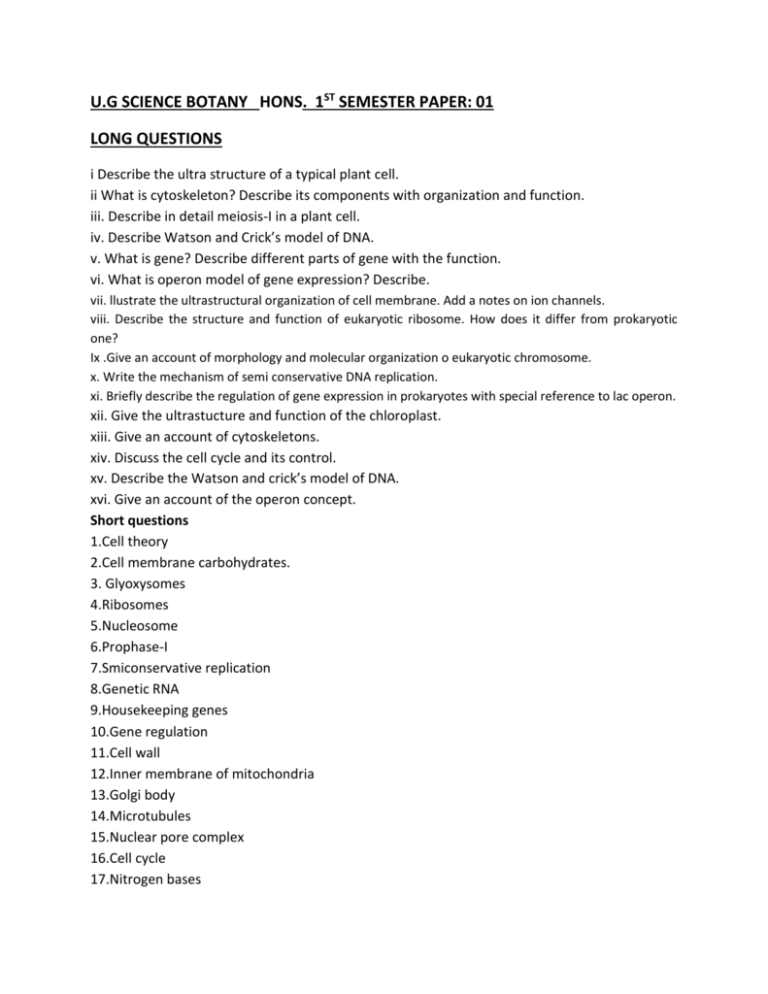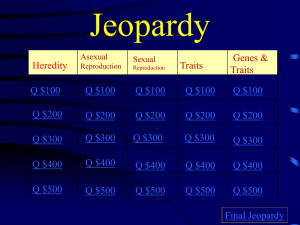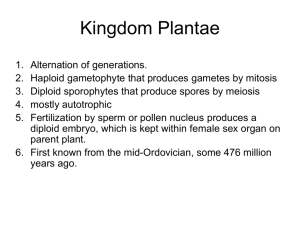question bank -botany (ug&pg)
advertisement

U.G SCIENCE BOTANY HONS. 1ST SEMESTER PAPER: 01 LONG QUESTIONS i Describe the ultra structure of a typical plant cell. ii What is cytoskeleton? Describe its components with organization and function. iii. Describe in detail meiosis-I in a plant cell. iv. Describe Watson and Crick’s model of DNA. v. What is gene? Describe different parts of gene with the function. vi. What is operon model of gene expression? Describe. vii. llustrate the ultrastructural organization of cell membrane. Add a notes on ion channels. viii. Describe the structure and function of eukaryotic ribosome. How does it differ from prokaryotic one? Ix .Give an account of morphology and molecular organization o eukaryotic chromosome. x. Write the mechanism of semi conservative DNA replication. xi. Briefly describe the regulation of gene expression in prokaryotes with special reference to lac operon. xii. Give the ultrastucture and function of the chloroplast. xiii. Give an account of cytoskeletons. xiv. Discuss the cell cycle and its control. xv. Describe the Watson and crick’s model of DNA. xvi. Give an account of the operon concept. Short questions 1.Cell theory 2.Cell membrane carbohydrates. 3. Glyoxysomes 4.Ribosomes 5.Nucleosome 6.Prophase-I 7.Smiconservative replication 8.Genetic RNA 9.Housekeeping genes 10.Gene regulation 11.Cell wall 12.Inner membrane of mitochondria 13.Golgi body 14.Microtubules 15.Nuclear pore complex 16.Cell cycle 17.Nitrogen bases 18. mRNA 19.Split gene 20.Typtophan operon 21. Structure of chloroplast 22. Lamellar models of cell membrane 23. Eukaryotic Ribosomes 24. Lysome 25. Lampbrush chromosome 26 Components of nucleoplasm 27. Mechanism of DNA replication 28. Types of RNA U.G SCIENCE BOTANY HONS. 2nd SEMESTER PAPER: 03 LONG QUESTIONS 1. Given an account of systematic position of microbes in biological world. 2. Describe the structure, nutrition and reproduction of Oscillatoria. 3. Enumerate the role of algae in human welfare. 4. Describe the characteristics and life cycle of rhizopus. 5. Describe the defence mechanism in plants with reference to biochemical aspects of pathogen attack. 1. What is meant by microbial? How pure culture is isolated and maintained? 2. Give an account of the industrial applications of microorganisms with specific examples. 3. Describe the different types of reproductions exhibited by Oedogonium. Give a graphic representations of its life cycle. 4. Explain the mode of reproduction in any heterocious and macrocyclic rust you have studied. 5. Give an account of the symptoms, causative organism, and transmission and control measures of the disease ‘Powdery Mildew’ 1. Describe the detailed structures of plant, animal and Bacterial viruses you have studied. 2. Discuss the role of microorganisms in ‘biogeochemical cycling’ of nitrogen and carbon. 3. Give an account of reproduction in Batrachospermum. Give a graphic representation of its life cycle. 4. Explain the mode of reproduction in Penicillium. add a note on its economic importance. 5. Give an account of the symptoms, causative organism, transmission and control measures of the disease ‘white rust’. a)Canker citrus b) potato leaf roll disease c) Continuous and synchronous culture Structure of TMV Endospore formation Biological nitrogen fixation Globule of chara Life cycle of batrachospermum Teleia Alternaria Control measures of viral diseases of plants White rust of Albugo Microbial growth curve Viroids and prions Heterocystons cyanobactria Recombination in bacteria Sexual reproduction in Vaucheria Vegetative structure of fucns Haplo-diplobiontic life cycle of saccharomyces Reproduction in fungus causing ‘Late Blight of Photo’ disease. Molecular manipulation of resistance a) Continuous and synchronous microbial culture b) Replication of bacteriophages c) Endospore formation in bacteriaContinuous and synchronous microbial culture d) Replication of bacteriophages a) Endospore formation in bacteria b) Archaebacteria c) Archaebacteria a) Reole of algae in human welfare b) Sex organs of chara a) Structre of basidiocarp of Agaricus b) Structure of reproduction in Colletotrichum a) Physical, physiological biochemical and molecular aspects of pathogen attack and defence mechanism U.G SCIENCE BOTANY HONS. 3rd SEMESTER PAPER: 05 Give an account of structure and development of sporogonium of Anthoceros. Add a note an its salient features. Discuss the evolution of stele in pteridophytes citing suitable examples. Describe briefly the process of reproduction in Equisetumk. Give an account of reproduction in Gnetum. Describe the vegetative and reproductive structures of Rhynia. Describe the theory of progressive sterilization of the potentially sporogenous tissue in bryophytes. What is heterospory? Describe how it leads to seed habit in selaginella. Describe the structure of the sporocarp of Masilea and comment briefly on its morphological nature. Give a detail account of reproduction of ginkgo. Describe the vegetative and reproductive structure of psilophyton Anthoceros represents a combination of simple gametophyte and highly advanced sporophyte. Discuss. Discuss the morphology and anatomical characters of Gnetu add a note on it’s affinitiesGive an account of morphology and anatomy of Equisetum stem and root. What is stellar concept? Discuss the different types of stele found amoung pteridophytes. What are fossils and what are the types? Discuss the proc of fossilization in detail. Describe the theory of progressive sterilization of the potentially sporogenous tissue in bryophytes. What is heterospory? Describe how it leads to seed habit in selaginella. Describe the structure of the sporocarp of Masilea and comment briefly on its morphological nature. Give a detail account of reproduction of ginkgo. Describe the vegetative and reproductive structure of psilophyton SHORT QUESTIONS Sporophyte of Machantia Gametophyte of porella Affinities of anthoceros and sphagnum Telome theory Stele of Lycopodium Sporophyte of lsoetes T.S through rhizome of equisetum Fertile spike of Ophioglossum Anatomy of Marsilea rhizome Pinus needle Male cone of cycas Affinities of gnetum Petrification Root of calamitea Flower of cycadeoidea Classification of bryophys Sporophyte of Gemmae cap Synatrigium Gametophyte of Lycopodium Rhizophore of selaginella Heterosporous ferns Cone of Equisetum Sporocarp of Azolla Wood of pins Affinities of Ginkgo Female gametophyte of Cycas Affinities of Rhynia Megasporophyll of Lepidodeadron Stigmaria Male cone of cycas Affinities of gnetum Petrification Root of calamitea Flower of cycadeoidea Smith’s classification of Bryophytes Gametophyte of Riccia Structure of sporophyte of Pellia Eam’s classification of pteridophytes Synangium of Psilotum Rhizophore of selaginella Gametophyte of Pteris Stem anatomy of osmunda Sporocarps of Azolla Morphological nature of ovuliferous scale of Pinus Anatomy of coralloid root of cycas Chamberlain’s classification of gymnosperms Lyginopteris Lepideodendron Compression fossils U.G SCIENCE BOTANY HONS. 4TH SEMESTER PAPER: 07 What is crossing over? Justify with a suitable example that cytological crossing over leads to genetic recombination. What do you mean by cytoplasmic inheritance? Explain the mechanism of plastid inheritance in Mirabilis. What is central Tendency? Describe the method of measurement of central tendency and mention their biological significance. What are the aim and objectives of plant hybridization? Describe the steps of hybridization in self-pollinating crops. Define mutation. Describe the molecular mechanism of gene Mutation. What is linkage? Explain how linkage data are used for chromosome mapping. Describe the mechanism of sex determination in plants. Classify polyploids. Discuss the role of allopolyploidy in evolution of plants with suitable examples. What is dispersion ? write the methods of measurement of dispersion Describe darwin’s views on origin of species. 1. Discuss Mendel’s law of Independent Assortment and find out the Dihybrid Ratio. 2. Describe cytoplasmic inheritance in yeast. 3. Describe the molecular mechanism of mutation. 4. Describe the various method of plant Breeding. 5. What do you mean by Central Tendency? Enlist its different types. Why Arithmetic mean is considered most suitable? Inheritance of human skin colour Epistasis Genic balance theory Hardy-weinberg principle Aneuploidy Inversion Hybrid vigour Modern synthetic theory Standard Deviation Chi-square test Supplementary factor Self incompatibility in plants Plastid inheritance in Mirabilis Sex-linked inheritance in Drosophila Chemical mutagens Duplication Pure line selection Mutation breeding Frequency distribution Student’s t-test a) Multiple allelism b) Molecular mechanism of crossing over a) Sex determination in animals b) Hardy- Weinberg principle a) Translocations b) Trisomics a) Hybrid Vigour b) Lamarckism a) Standard deviation b) Chi- square test U.G SCIENCE BOTANY HONS. 5TH SEMESTER PAPER: 09 1. What is pH.? Describe how the pH of water is 7.0. Mention the important of pH in biological systems. 2. What are enzymes? Describe the modes of enzyme action. 3. Describe the structures and function of Lactose, mal and sucrose. 4. What are vitamins? Describe the sources, structures functions of any four vitamins. 5. Describe the principle and functions of spectrophotometer 6. at do you mean by thermodynamics? Explain the laws of Thermodynamics. 7. What are proteins? Describe the levels of structural organization of proteins. 8. How are carbohydrates classified? briefly describe the structure and functions of a storage 9. . What are Lipids? Describe the classification and functions of lipid. 10. Describe the procedure for cell fractionation. Add a note on its uses. 11. Describe Henderson-Haselbach equation. Mention the uses of this equation. 12. What are enzymes ? Write the mechanism of enzyme action. 13. Describe the structure and function of disaccharides. 14. What are coenzymes? Give the structure and function of coenzymes. 15. Write the principle and methods of gel electrophoresis. 16. 17. 18. 19. 20. 21. 22. 23. 24. 25. a) Free energy b) Redox potential a) Glutamic acid b) Quarternary structure of protein a) Isomers b) Cellulose a) Fatty acid b) A.T.P a) Paper chromatography b) Gel electrophoresis 26. 27. 28. 29. 30. 31. 32. 33. 34. 35. a) Buffer b) ATP a) Non-protein amino acids b) Michaelis-Menten equation 3. polysaccharide. a) Mutarotation b) Monosaccharides 4a) Co-enzyme b) Vitamin C 5. a) Autoradiography 36. (a) Covalent bond 37. Properties of water 38. Secondary structure of protein 39. Activation energy 40. Kiliani-Fisher synthesis 41. Qualitative test for carbohydrate 42. Unsaturated fatty acids 43. Vitamin D 44. Ultra centrifuge 45. Colorimetry 46. Fluorescence Microscopy U.G SCIENCE BOTANY HONS. 5TH SEMESTER PAPER: 10 1. Describe the structure and development of endosperm in angiosperms. 2. Discuss the principles behind the distribution of mechanical tissue in plant organs 3. Describe briefly the steps of recombinant DNA technology for gene cloning. 4. What is DNA finger printing? Describe the technique and discuss its application. 5. What is anomalous secondary growth? Describe, with neat labeled diagram, the adaptive type of anomalous secondary growth in Aristolochia stem. 6. Describe the method of Agrobacterium mediated genetic transformation in plants. 7. Describe different steps used in plant tissue clture and explain, how it helps in micropopagation 8. Give an account of domestication of plants a suggested by vavilov with special reference to primary and secondary centres of diversity an plant introduction. 9.Describe the structure and development of female gametophyte. 10.Describe the development of embryo starting from zygote in capsella bursa-pastoris. Describe the characteristics of a meristem. Write briefly the various theories on organization of shoot apical meristem. 11.Give a comprehensive account of Recombinant technology. 12. What is totipotency? Describe the process of isolation culture of protoplasts. State the economic aspect protoplast culture. Short Questions (a) Maize (b) Black gram (c) Sugar cane (d) Sunflower (e) Coir (f) Hevea h) Turmeric (b) Saffron (c) Fenugreek (d) Rauwolfia (a) Restriction endonuclease (b) Isolation of DNA fragment ) Tunica-corpus theory (b) Secondary growth in Boerhaavia (a) Apomixis (b) Microgametogenesis (a) Northern blotting (b) Protoplast (a) Restriction endonuclease (b) Isolation of DNA fragment (a) Northern blotting (b) Protoplast a) Wheat b) Chick pea c) Green gram d) Cloves e) Ginger (d) Rauwolfia a) Secretory tissue b) Periderm a) Pollen stigma interaction b) Morphological nature of endosperms a) Prokaryotic and Eukaryotic cloning vectors b) Transgenic plants a) Secretory tissue b) Periderm a) Pollen stigma interaction b) Morphological nature of endosperms a) Prokaryotic and Eukaryotic cloning vectors b) Transgenic plants a) c DNA libraries b) Somatic hybridization U.G SCIENCE BOTANY HONS. 6TH SEMESTER PAPER: 12 Long Questions 1. Describe the structure and development of female gametophye 2. Describe the method of Agrobacterium mediated genetic transformation in plants. 3. What is anomalous secondary growth? Describe, with neat labeled diagram, the adaptive type of anomalous secondary growth in Aristolochia stem. 4. Give an account of domestication of plants a suggested by vavilov with special reference to primary and secondary centres of diversity an plant introduction. 5. Describe different steps used in plant tissue clture and explain, how it helps in micropopagation. Short Questions a) Pollen stigma interaction b) Morphological nature of endosperms a) Secretory tissue b) Periderm a) Prokaryotic and Eukaryotic cloning vectors b) Transgenic plants a) c DNA libraries b) Somatic hybridization a) Wheat b) Chick pea c) Green gram d) Cloves e) Ginger a) Nemec phenomenon b) Experimental embryology 2. a) Non-adaptive anomalous secondary growth (one example only) b) Anomalous secondary growth in a Bignonia. 3a) Genetic engineering in plants b) Vectors for gene therapy a) Gel Electrophoresis b) DNA Finger Priniting . Describe the botany, alkaloids obtained and economic importance of the following plants. a) Ocimum b) Eucalyptus c) Vinca d) Melia How are the following flowering plants are economically useful to human being? Write the botanical name with family. a) Ragi b) Sugar beet c) Turmeric d) Black peper U.G SCIENCE BOTANY HONS. 6TH SEMESTER PAPER: 13 Long questions 1. Describe the salient features of the international Code of Botanical nomenclature . 2. Explain the classification of Bentham and Hooker’s commenting on its merits and demerits 3. Write an essay on energy flow in Ecosystem. 4. What is Soil? How does it influence the vegetation of a place? 5. Give an account of mechanism of stomatal transpiration and its significance 6. Discuss the causes, effects and control measures of Air Pollution. 7. What is Respiration? Give an account of mechanism of oxidative phosphorylation. 8. Give an account of role of micronutrients and macronutrients in plants. Give an account of genetic code in eukaryotes with its significance 9. What is Phyto-hormones? Give an account of discovery, role and mechanism of action of Auxins. Short questions (a) (b) (c) (d) (e) (f) (g) (h) (i) (j) (k) (l) (m) (n) (o) (p) (q) (r) Importance of herbarium specimen and their preparation. Concepts of species Primitive living angiosperms Natural system of classification Cytology as tools in taxonomy Demerits of takhtajan system of classification Adaptations Biomes Types of biotic infraction Concepts of ecosystem Aquatic ecosystem A short account of vegetation of India Endangered species Radioactive pollution Environmental impact assessment Water potential and its components Ascent of sap Transport of photosynthate (s)Mechanism of mineral absorption (t)Photolysis of water (u)C4 cycle (v) Reductive amination (w)Protein targeting and degradation (x)Tropic movement in plants (y)Mechanism of vernalization










